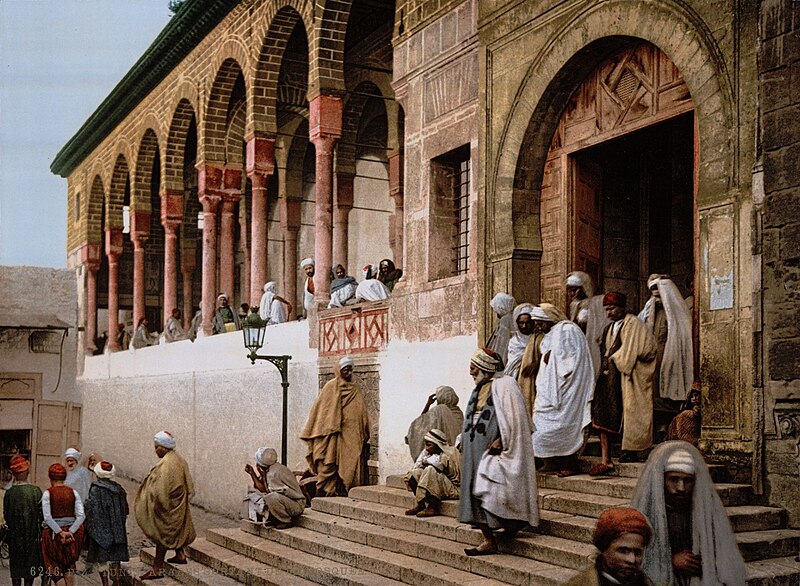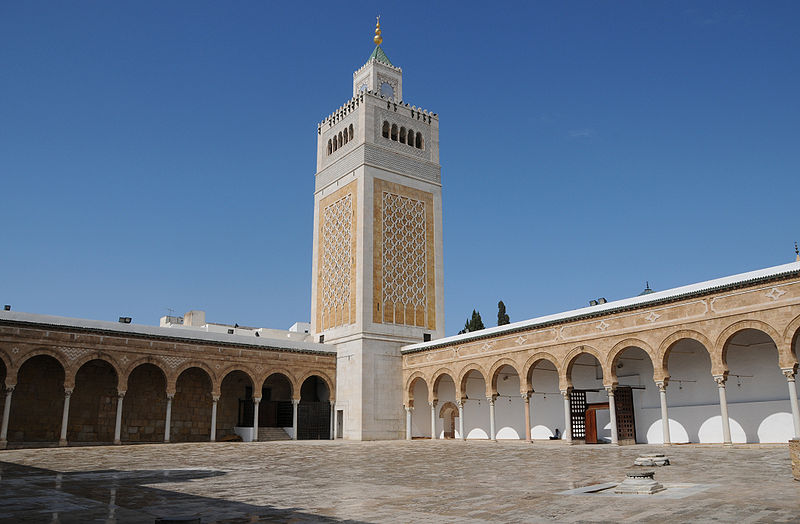
Az-Zaytouna – the oldest mosque and the famous Muslim University of Tunisia
Located in the heart of Tunisia, this mosque is also known as Jami al-Kabir (Great Mosque) because it is the largest in the city.
The first mosque on this site was built by Hasan ibn Numan in 699, later it was rebuilt by Ibn Khabba in 732-734. It was the second Muslim temple after the Great Mosque of Kairouan , built in Ifriqiya and Maghreb. Later it was expanded and restored by caliphs from different dynasties, and it acquired its final appearance after extensive restoration work carried out by the Ottomans in 1834 and 1896.
The mosque is rectangular in plan and consists of a closed part and a courtyard with a portico, covering an area of 5000 square meters. Reportedly, 160 of the columns installed here were brought from the ruins of Carthage. A massive square minaret with a height of 44 meters is noteworthy . Az-Zaytuna with its layout, courtyard with galleries, as well as horseshoe-shaped arches on marble columns, two-tone stone compositions and plaster decorations served as a model for later mosques in Tunisia.

Mosque of al-Zaytun in 1880 / Source: en.wikipedia.org
For centuries, al-Zaytun was home to one of the first and greatest universities in the history of Islam, from the walls of which many prominent scholars emerged, such as the famous Ibn Khaldun, who is called the father of political economy, sociology and political science. Madrasah here was created back in 737. Since the 13th century, when Tunisia became the capital of Ifriqiya, under the Almohad and Hafsid dynasties, al-Zaytouna flourished, becoming one of the main centers of Islamic education, where students and scholars from all over the Islamic world aspired. Along with religious sciences, they taught law, history, grammar, medicine, astronomy. Az-Zaytuna possessed the richest library in North Africa. It had several collections numbering tens of thousands of books. Thanks to the influence of al-Zaytuna, in which the Maliki madhhab was studied, the latter spread throughout this region.
After the fall of the Hafsid dynasty, the decline of al-Zaytuna was outlined. The Spaniards also contributed by capturing Tunisia in 1535 and 1537 and burning the university library.
Some revival began after the entry of Tunisia into the Ottoman Empire. Andalusian scholars, who began to arrive in North Africa after the expulsion of Muslims from Spain, contributed to the activities of al-Zaytuna during this period.

Source: en.wikipedia.org
In the first half of the 19th century. Turkish authorities carried out reforms in al-Zaytunby making learning more systematic. Further transformations were made during the French protectorate (1881-1956). In 1946, the curriculum included mathematical and natural sciences, history, geography and philosophy. The most important step towards the modernization of education was the opening in al-Zaytun in 1951 of the al-Shubat al-asriya school, where, in addition to Arabic, French and English were also taught. At this time, almost all the imams and preachers working in the country’s mosques were al-Zaytuna graduates. Also, many clergymen in Morocco, Tripoli, Algeria and Mauritania studied at this educational institution. Al-Zaytouna’s graduates were in a special place in Tunisia. Among them were not only religious figures, but writers, poets, secular scientists.
After Tunisia gained independence in 1956, al-Zaytouna was transformed into the University of al-Zaytouna (al-Jamiatu al-Zaytouna). But since the 60s, the state has been putting pressure on its graduates. They are not allowed to hold positions in state structures, education in al-Zaytun has ceased to be prestigious. Therefore, many of its graduates were forced to emigrate to other countries of the East or the West.

Photochromic printing. Main entrance (1890) / Source: en.wikipedia.org
Source: en.wikipedia.org

Source: en.wikipedia.org
Source: en.wikipedia.org

Source: en.wikipedia.org

Source: en.wikipedia.org

Source: en.wikipedia.org

Source: en.wikipedia.org

Source: islamansiklopedisi.org.tr

Source: ru.wikipedia.org

Source: islamansiklopedisi.org.tr
Islamosphere

